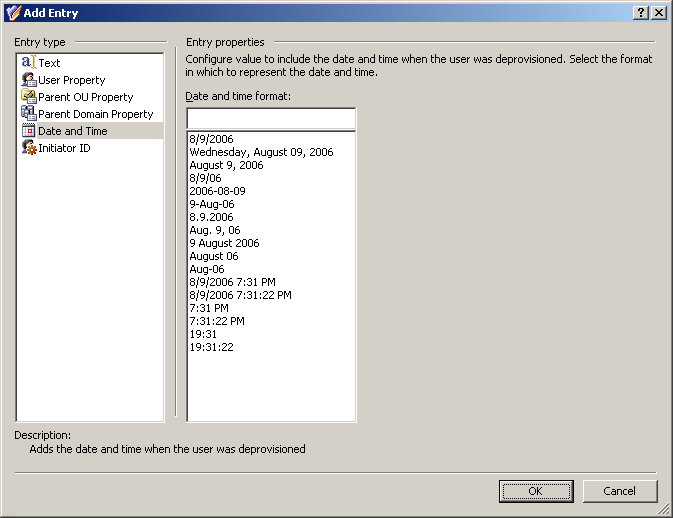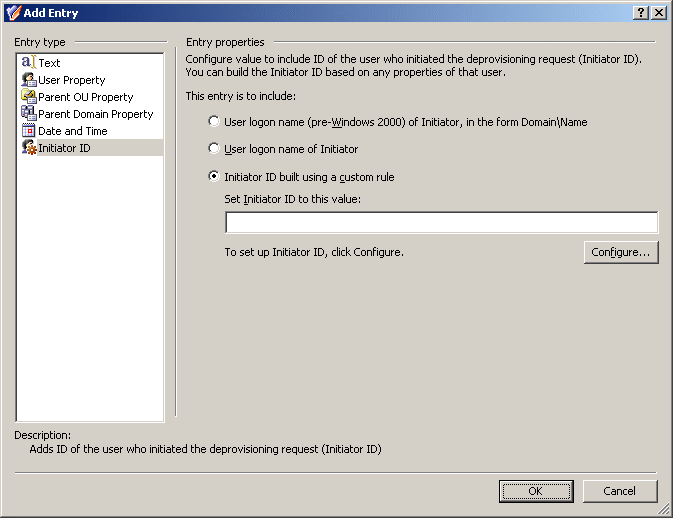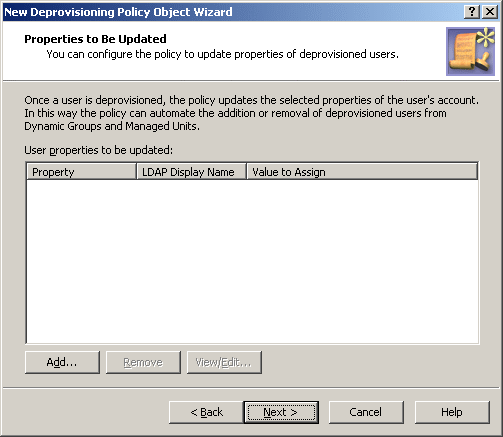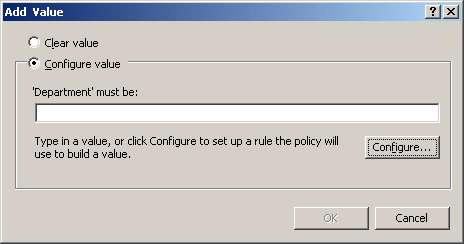Entry type: Date and Time
When you select Date and Time under Entry type in the Add Entry window, the Entry properties area looks like the following figure.
Figure 69: Entry type: Date and Time

Using this entry type, you can add an entry that represents the date and time when the user account was deprovisioned.
In the list under Date and time format, click the date or time format you want. Then, click OK to close the Add Entry window.
Entry type: Initiator ID
When you select Initiator ID under Entry type in the Add Entry window, the Entry properties area looks like the following figure.
Figure 70: Entry type: Initiator ID

With this entry type, you can add a string that identifies the Initiator, that is, the user who originated the deprovisioning request. The policy generates the Initiator ID based on certain properties of the Initiator’s account, such as the user logon name. A custom rule can be configured to use other properties.
You can choose a pre-configured rule or configure a custom rule to generate the Initiator ID. The pre-configured rules allow you to set the Initiator ID to one of the following:
- The pre-Windows 2000 user logon name of the Initiator, in the form DomainName\UserName
- The user logon name of the Initiator
A custom rule allows you to compose the Initiator ID of other Initiator-related properties.
Configuring a custom rule to build the Initiator ID
To configure a custom rule for Initiator ID, click the lowermost option under Entry properties, and then click the Configure button. This displays the Configure Value dialog box, discussed earlier in this chapter (see How to configure a Property Generation and Validation policy). You can use that dialog box to set up a value for the ‘Initiator ID’ must be condition, in the same way as you do when configuring a Property Generation and Validation policy.
To start configuring a value, click Add in the Configure Value dialog box. This displays the Add Entry window.
A value is a concatenation of one or more entries. In the Add Entry window, you can select the type of the entry to add, and then configure the entry. The following table summarizes the available types of entries.
Table 22: Available entries for Configuring a custom rule to build the Initiator ID
|
Text |
Adds a text string to the value. |
|
Initiator Property |
Adds a selected property (or a part of a property) of the Initiator’s user account. |
|
Parent OU Property |
Adds a selected property (or a part of a property) of an organizational unit in the hierarchy of containers above the Initiator’s user account. |
|
Parent Domain Property |
Adds a selected property (or a part of a property) of the domain of the Initiator’s user account. |
Instructions on how to configure an entry depend on the type of the entry. For each type of entry, you can find the instructions in the How to configure a Property Generation and Validation policy section, earlier in this chapter:
When you are done configuring a value for the ‘Initiator ID’ must be condition, click OK to close the Configure Value dialog box. This will add the value to the Initiator ID entry properties. If necessary, you can modify the value by clicking the Configure button in the Add Entry window and then managing the list of entries in the Configure Value dialog box.
When you are done configuring the Initiator ID entry, click OK to close the Add Entry window. The entry is added to the Configure Value dialog box for the ‘name’ must be condition.
When you are done configuring a value for the ‘name’ must be condition, click OK to close the Configure Value dialog box. This will add the rule to the Options to Prevent Logon page of the wizard. If necessary, you can modify the rule by clicking the Configure button on that page and then managing the list of entries in the Configure Value dialog box.
Once you have completed the Options to Prevent Logon page, click Next to display the Properties to Be Updated page.
Figure 71: Properties to Be Updated

On this page, you can set up a list of user properties you want the policy to update. Each entry in the list includes the following information:
- Property. When deprovisioning a user, Active Roles will update this property of the user’s account.
- LDAP Display Name. Uniquely identifies the property to be updated.
- Value to Assign. After the deprovisioning operation is completed, the property has the value defined by this syntax.
You can use these buttons to manage the list on this page:
- Add. Allows you to select a user property and configure an update rule for that property. A property update rule specifies how to generate the new value to assign to the property.
- Remove. If you want the policy to no longer update a given property, select the property from the list and click Remove.
- View/Edit. Allows you to modify the update rule for the property you select from the list.
Clicking the Add button displays the Select Object Property dialog box where you can choose user properties you want to the policy to update. To choose a property, select the check box next to the property name, and then click OK.
You can select multiple check boxes. If you do so, the properties you have selected are added to the list on the wizard page, with the update rule configured to clear those properties, that is, to assign them the empty value.
If you select a single property in the Select Object Property dialog box, you are presented with the Add Value dialog box so you can proceed to configuring a property update rule.
Figure 72: Add Value

You can select one of these update options:
- Clear value. Causes the policy to assign the empty value to the property.
- Configure value. Allows you to configure a value for the ‘property’ must be condition.
With the second option, you must configure a value the policy will assign to the property upon the user deprovisioning. You can configure a value in the same way as you do when configuring a property update rule for the user name: Click the Configure button and follow the instructions provided earlier in this section (see Configuring a property update rule).
When you are done configuring a value, click OK to close the Add Value dialog box. The property name along with the property update rule is added to the wizard page. If necessary, you can modify the update rule by clicking the View/Edit button beneath the list of properties. This displays a dialog box, similar to the Add Value dialog box, allowing you to choose a different update option or set up a different value for the ‘property’ must be condition.
Once you have set up the list on the wizard page, click Next and follow the instructions in the wizard to create the Policy Object.
To configure a User Account Deprovisioning policy
- On the Policy to Configure page, select User Account Deprovisioning, and then click Next.
- On the Option to Prevent Logon page, select the options you want the policy to apply when deprovisioning a user account. You can select any combination of these options:
- Disable the user account
- Set the user’s password to a random value
- Set the user logon name to a random value
- Set the user logon name (pre-Windows 2000) to a random value
- Rename the user account to
- If you selected Rename the user account to, click Configure, and then complete the Configure Value dialog box by using the procedure outlined later in this topic, in order to specify how you want the policy to update the user name when deprovisioning a user account.
- Click Next.
- On the Properties to Be Updated page, specify how you want the policy to update user properties when deprovisioning a user account:
- Click Add, and then complete the Select Object Property dialog box by using the procedure outlined later in this topic, in order to add property update rules.
- Use View/Edit to modify existing rules.
- Use Remove to delete existing rules.
- Click Next.
- On the Enforce Policy page, you can specify objects to which this Policy Object is to be applied:
- Click Add, and use the Select Objects dialog box to locate and select the objects you want.
- Click Next, and then click Finish.
To complete the Configure Value dialog box
- Click Add.
- Configure an entry to include in the value (for instructions, see Steps for configuring entries).
- In the Configure Value dialog box, add more entries, delete or edit existing ones, and then click OK.
To complete Select Object Property dialog box
- From the Object property list, select an object property, and then click OK. The Add Value dialog box appears.
If you select multiple properties, the Add Value dialog box is not displayed. The properties you have selected are added to the list on the Properties to Be Updated page, with the update rule configured to clear those properties, that is, to assign them the “empty” value.
- In the Add Value dialog box, do one of the following:
- Select Clear value if you want the update rule to assign the empty value to the property.
- Select Configure value if you want the update rule to assign a certain, non-empty value to the property. Then, click Configure and complete the Configure Value dialog box by using the instructions given earlier in this topic.




